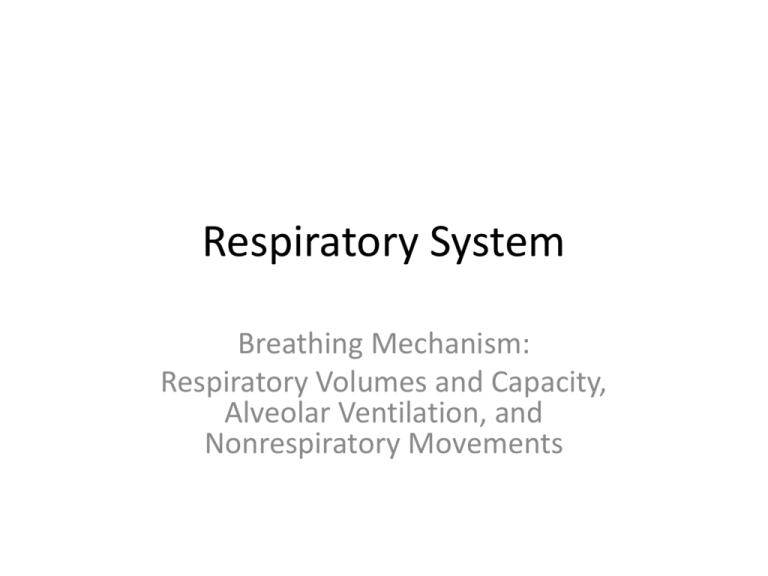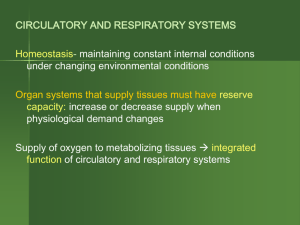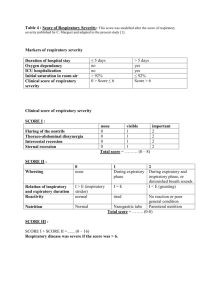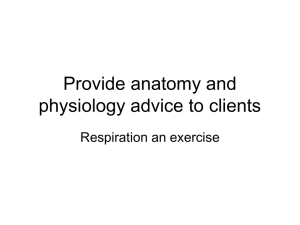Respiratory System
advertisement

Respiratory System Breathing Mechanism: Respiratory Volumes and Capacity, Alveolar Ventilation, and Nonrespiratory Movements Respiratory Volumes • The different volumes of air that enter or leave the lungs – Can be divided into four different volumes: • • • • Resting tidal volume Inspiratory reserve volume Expiratory reserve volume Residual volume Spirometry • Study of respiratory volumes Spirometer • Used to measure respiratory air volumes (except residual volume) – These volumes can then be used in the evaluation of respiratory illnesses Respiratory Cycle • One inspiration and one expiration Tidal Volume • Volume of air that enters or leaves during a respiratory cycle Resting Tidal Volume • Volume of air that enters or leaves during normal, resting inspiration and expiration – About 500 mL Inspiratory Reserve Volume • Volume of air taken in during forced maximal inspiration in addition to the resting tidal volume – Equals about 3,000 mL Expiratory Reserve Volume • Volume of air expelled from the lungs during maximal forced expiration in addition to the resting tidal volume – About 1,100 mL Residual Volume • Air that remains in the lungs – (About 1,200 mL even after the most forceful expiration) • Mixes with newly inhaled air – Prevents the CO2/O2 concentrations from fluctuating greatly with each breath Vital Capacity • The maximum volume of air a person can exhale after taking the deepest breath possible • Equal to tidal volume plus inspiratory reserve volume plus expiratory reserve volume – About 4,600 mL Inspiratory Capacity • Maximum volume of air a person can inhale following a resting expiration • Equal to the tidal volume plus the inspiratory reserve – About 3,500 mL Functional Residual Capacity • Volume of air that remains in the lungs following a resting expiration • Equal to the expiratory reserve volume plus the residual volume – About 2,300 mL Total Lung Capacity • Equal to the vital capacity plus the residual volume – About 5,800 mL – Total varies with gender, age, and body size Anatomic Dead Space • Created by air that is inspired (about 150 mL) but remains in the trachea, bronchi, and bronchioles where gas exchange does not occur Alveolar Dead Space • Created by nonfunctional air sacs (due to poor blood flow in adjacent capillaries) Physiological Dead Space • Total volume of the anatomical dead space and the alveolar dead space – Volume is essentially the same as the volume of the anatomical dead space (about 150 mL) Minute Ventilation • Volume of air moves into the respiratory passages each minute • Equal to the tidal volume multiplied by the breathing rate • Much of this new air remains in physiological dead space Alveolar Ventilation Rate • Volume of new air that reaches the alveoli and is available for gas exchange • Equal to (the tidal volume minus the physiological dead space) multiplied by the breathing rate – (500 mL – 150 mL) x 12 breaths/min = 4,200 mL/min Nonrespiratory Air Movements • Air movements that occur in addition to breathing • Used to clear air passages or to express emotions • Usually result from reflexes but can also be triggered through conscious effort Coughing • Used to clear the lower respiratory passages • Involves: – Taking a deep breath – Closing the glottis – Forcing air upward from the lungs against closure – Suddenly opening the glottis – And forcing a blast of air upward from the lower respiratory tract Sneezing • Clears the upper respiratory passages • Usually triggered by an irritant in the lining of the nasal cavity • Similar to a cough but in the process of sneezing the uvula is depressed directing the upward forced air to enter the nasal passages Laughing • Involves a person taking a breath and releasing it in a series of short expirations Crying • Works through the same process as laughing Hicupping • Caused by a sudden inspiration due to a spasmodic contraction of the diaphragm while the glottis is closed • Associated noise is caused by air striking the vocal cords • Function of hiccups is not known Yawning • A deep inspiration that involves the glottis and mouth being open • Why we yawn and why it is “contagious” are not understood







